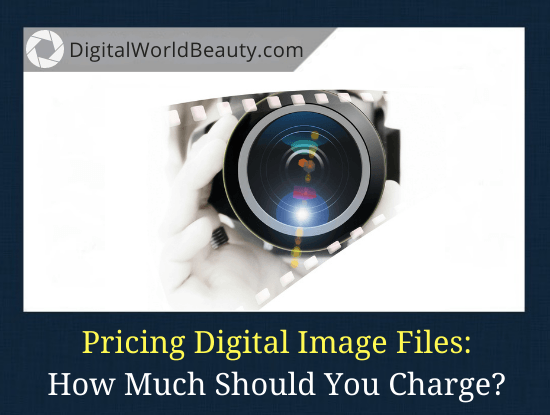Please note: As an Amazon Associate I earn from qualifying purchases. I also work with other affiliate partners and may be compensated from the links below. Details here.
Pricing Digital Image Files: What Is a Digital Download Picture & How Much to Sell It For?

Pricing digital image files: How much to charge for download pictures? (Guide)
Let’s face it:
Digital images are a key component in any photographer’s portfolio.
These files can be downloaded to your computer for easy access or printed out on paper, canvas, metal, and more. However, pricing them can be a difficult task.
What is a digital download picture? How much is my picture worth? What should I charge for it? Price varies depending on the size of the print, what type of image it is (family portrait or child’s birthday party), etc.
Below are some helpful tips and answers to your questions. Let’s get started.
But First… A Bit of History
It sounds simple. But what is digital photography?
It is a form of art that has evolved. Now that almost everything that we do is online, access to non-printed imagery opens a world of opportunities.
It is the process of utilizing photodetectors – or photosensors – to repurpose light to create a picture. Rather than having to use a darkroom to compose your shot, they are directly imported as computer files.
The process of electronics to capture the image allows for greater flexibility while editing as well as saving and exporting them.
In 1975, Steve Sasson changed this industry forever with the creation of the first digital camera while working as an engineer for Eastman Kodak. Each 0.01-megapixels photo took 23 seconds to create – a far cry from the 3 to 5 days that it takes to create them in a darkroom.
Over the years, this industry has increased rapidly, both in reach and in quality.
As online photography is a lucrative business, file downloading allows you to sell your work faster. With this easier accessibility, the client receives a copy of the photo that has been edited – and can get it from a direct link – allowing them to use it as needed.
The Benefits of Digital Imaging
Look:
One of the clear benefits of selling digital images is the ease with which the product is delivered to the client. Reaching a greater audience that is directly targeted to the created content at a moment of notice can make all the difference in gaining repeat business.
Presenting a library of photos that can be selected from can be the basis of a lucrative career.
Having pictures available for a client to select from on-demand can make the difference between successfully selling your work to a wider audience rather than a select few.
Digital imaging allows for a library of content to be available for viewing when a client needs an image quickly – and depending on which method is used to market them, you can entice clients with deals on repeat business.
How to Sell Digital Photography

So, how much to sell digital photos for?
Without a doubt, starting can be a daunting process. It comes down to three factors – selling, image rights, and the file download itself. Let’s cover each of these.
-
Selling the digital image:
Selecting a third-party website to list your shot as stock photos is an effective way to reach a greater audience. The other advantage that comes with utilizing a third-party platform to market your work is that they handle the back end of the transaction – making the “selling” part fast and easy.
-
Image rights:
Digital image copyright licensing – is the process in which a company or individual can legally have ownership over the photos.
Once you become a license holder, the pictures can then be used both professionally and personally. While the shot is still the property of the creator, the purchasing process means that the creator is permitting it to be used elsewhere.
When it is sold through a third-party website, oftentimes while the photographer still maintains the rights, purchasers are not required to list the creators’ name when using the pic.
-
Imaging downloading:
There are a variety of methods to sell work through the process of a digital download. If using a third-party website, a client can purchase directly through the website and instantly download the image.
Other people prefer to market their content directly through their website, setting up a Paypal (or another form of online payment platform) and then sending their pics personally to the client.
Popular third-party sites such as Shuttershock, iStock Photo, Getty Images, 500px, and Stocksy offer royalty-free content for clients to download. A percentage of the sale is then sent to the content creator.
Since clients utilizing the website have the option of single or multiple downloads, the photographer is paid a set rate for the number of shots selected/purchased.
Perhaps the best way to sell digital photography is through the creation of your website.
Selling it directly means that you’re cutting out the middleman, all of the profits go directly to you. This can be as easy as creating a WordPress site and adding a payment button.
Like with a third-party website, creating a watermark over your image is essential. This ensures that only those to whom you have agreed to sell your rights for their personal or professional use can use them.
While creating a personal website does include the added task of marketing yourself, social media are a powerful tool in getting your name out there and providing a sampling of your imagery.
Pricing: Amateur vs Professional Photographers
Several factors go into the pricing of digital image files.
Your level of experience, portfolio, amount of time spent working, cost of labor or resources, and terms of use regarding royalties all come into play. The more unique and harder to create the art is, the more value it will have, at least in monetary respects.
With experience and a growing portfolio, you have a greater chance of asking for a higher price. Starting at the beginning, expect to sell the soft-copy of your images on the lower side of the pay scale. Most stock sites offer around .$/25 to.$.50 per download.
Setting professionals apart is the sheer volume, quality of their shots, and editing. As your portfolio grows and you attract a greater following, you can expect to charge more for them. Pricing comes down to three factors:
- What is the quality of your photos?
- Have they been edited or retouched properly?
- How many past projects have you completed?
Digital imagery is not only a method to virtually create a picture – but it also allows for the easy and fast process of editing. The faster that a client receives a professional-looking image, the more likely they are to do business with you again.
How to Reach the Right Audience
So you’ve created a library of digital content. What next?
Photography is a vast profession with seemly endless possibilities. The creation of digital imaging revolutionized the way that we can gain access to content. Both through personal distribution or through a third party, properly tagging and naming is a must.
For example, a client is looking for a picture that will be used to showcase something as simple as travel can benefit from tags that reference the country, specific area, the location’s name, and even down to the detail of what the eye is drawn to in the shot.
An online picture that features the Coliseum could gain viewership with tags that reference history, architecture, Italy, tourism, and the name itself.
It comes down to a fine balance depending on the platform that you are using as to how many tags should be included.
Social media sites often benefit and gain a wider audience through fewer, more pointed tags – while third-party sites and personal websites can include a greater search engine optimization (SEO) reach for your content.
In the end, it comes down to how much control you would like to have over the profit from your shots. It is also essential that you know how much work you can do with the marketing aspect of the process. Digital imaging and downloading are powerful tools for showcasing your work to the intended audience.
Now, I’d like to hear from YOU:
- What is your experience of pricing digital image files?
- How much should you sell your photo rights for?
- How much should you charge for digital downloads?
Let us know your thoughts in the comments below!